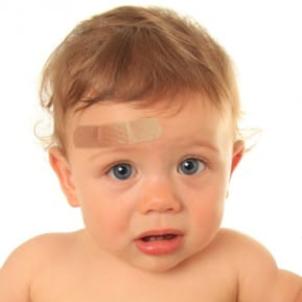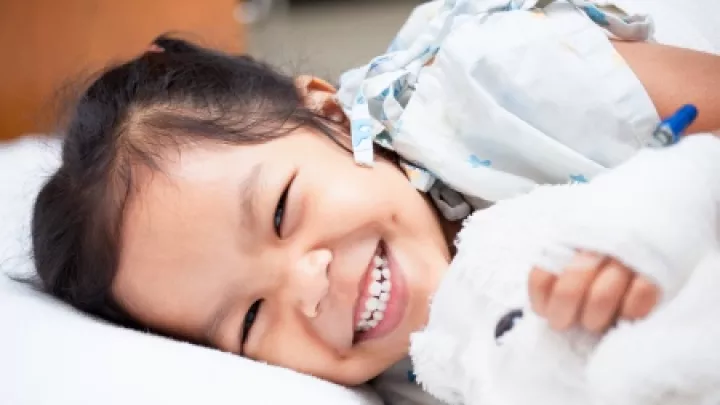
First Aid 101 for Parents
Do you know what to do if your child gets a bloody nose, sprains their ankle, or gets a big scrape? I have friends and family members who literally keep me on speed dial every time someone in their house gets hurt. This got me thinking: what if you don’t have your own personal nurse at your disposal?
I think that all parents should have a few basic first aid skills up their sleeve, because you just never know when they may come in handy! I would also encourage ALL parents to take a basic CPR and first-aid class, because knowing these skills could literally save someone’s life.
I remember taking a first aid course when I was in Girl Scouts, and being fascinated with first aid and feeling very proud that I “knew what to do” in various basic first aid scenarios. I realize as an adult how valuable this experience was for me. I wonder if my 6 year-old nephew would know what to do if someone bumped their head or started to bleed? I hope that this article helps to spark your interest in first aid and provides you with some useful knowledge that you can also share with your child as well.
Check your cupboards
Do you have the foundations for a first-aid kit? Performing first aid at home is certainly easier if you have some basic first aid supplies available. Here are some basics that you should make sure to have at home:

- Adhesive bandages in various sizes
- Antiseptic solution or wipes
- Latex-free gloves
- Instant cold compress
- Antibiotic ointment (bacitracin, Neosporin, triple antibiotic ointment, etc.)
- Sterile gauze pads (4x4 inch)
- Elastic bandage
- Thermometer
- Scissors
- Medical tape
- Cotton balls
- Soap/hand sanitizer
- First aid manual
Make a binder
Create a binder at home that contains important numbers and information for everyone in your family. Include their ages, doctors’ names and numbers, and a list of preexisting medical conditions, prior surgical history and known allergies. Write down your child’s weight, as pediatric medications are dosed by weight. Update this information periodically. Make sure your child knows where this information is located as well.
Talk to your child about 911
Ask children if they know when to call 911. Make sure that they actually know how to dial the number on the phone as well. Also ensure that your child knows their address in case of an emergency.
First Aid 101
Choking
- If your child is choking but conscious, coughing, and able to talk, let him or her keep coughing to clear the object from the airway. Remain calm and stay closeby until the episode passes.
- Do not hit the child on the back as this could push the object down the airway further.
- Do not reach into the mouth to try to retrieve the object as this could also push it down the airway.
- If your child is choking and starts to become unable to talk, cough or make noise, yet remains conscious, call 911 or shout for someone to do so, and do abdominal thrusts (The Heimlich maneuver) if you have been trained properly to do them. It is a good idea to take a first aid or CPR class to learn this technique in case of an emergency.
- If your child loses consciousness and is no longer breathing, start CPR if you have been properly trained properly to do so, shout for help, and call 911.
Minor cuts and scrapes
- Wash your hands with soap and water before tending to any open wounds.
- If you have gloves, it’s a good idea to put them on any time you’re dealing with blood/body fluids.
- If there is light bleeding, elevate the wound and apply gentle pressure with a sterile gauze or clean cloth.
- Rinse away any debris with water and clean the wound with antiseptic solution or soap and water.
- Apply antibiotic ointment if you have some, but know what you are applying, especially if you are aware that your child has allergies.
- Apply an adhesive bandage to keep dirt and bacteria out of the wound and make sure to change it at least once a day or whenever the bandage becomes soiled. You can remove the dressing when it looks like the wound has started to heal, as exposure to air helps to accelerate healing.
- If it’s just a small scratch/scape, or there is not much bleeding or depth to the wound, you may not need to cover it with a bandage.
- Have the wound checked by a doctor if the wound becomes red, swollen, painful, or is draining pus.
- Small cuts and scrapes generally don’t require a trip to the emergency room, but if there is any doubt whether or not something needs stitches or starts to look infected, it is best to just have it looked at by a doctor.
Severe bleeding
- If blood is rapidly oozing out, call 911.
- Until you can get medical attention, wash your hands or wear gloves and apply firm pressure with a sterile gauze or cloth (if you have one available) and keep the wound elevated above the heart.
- If blood continues to ooze through the bandage, reinforce the old dressing with a new layer without removing the old ones. If you don’t have a cloth or gauze available, use clothing or even your hand to cover the bleed, but don’t remove the pressure until help arrives.
Bloody nose
- Pinch the nostrils shut with your thumb and index finger with a tissue, paper towel, or clean cloth for about five to 10 minutes.
- Ask your child to sit up straight, lean forward, and breathe through the mouth.
- Instruct your child not to blow their nose during or immediately after the nosebleed.
- Seek emergency assistance if your child’s nose won’t stop bleeding after firmly pinching for about 10 to 15 minutes or if the bloody nose follows an accident like a fall, head injury, punch, or hit from a ball.
Fever – If you think your child has a fever, make sure to take his or her temperature with a thermometer. Although you may be able to tell that there is a fever just by touching your child’s forehead or back, make sure to use a thermometer to get the actual reading. For more diagnoses and treatment options, check out Don't Sweat It: Treating a Child's Fever by Gloria Verret, BSN, RN III, CPN at CHLA.
Sprains and Strains – A sprain occurs when a ligament (the tissue that holds bones together) gets pulled, overstretched or partially torn. A strain is when a muscle or tendon is stretched or partially torn. Both cause swelling, bruising or pain. It can be hard to tell the difference between a strain and a break without an X-ray, so make sure to take your child to be evaluated by a doctor. In the meantime, use the acronym RICE for suspected sprains and strains:
- R – Rest after an injury. Keep weight off the area and limit activity for at least 24 hours.
- I – Ice with a cold pack hourly for at least 10 to 15 minutes for the first two days to prevent swelling. Wrap the cold pack in a towel to prevent the cold from causing injury to the skin.
- C – Compress the area with an elastic bandage for at least two days to minimize swelling.
- E – Elevate the injured area at or above heart level if possible. However, If your child’s injury involves the back or neck, do not move him or her (unless the child is in imminent danger), in order to prevent nerve damage. Call 911 instead.
Head Injuries – It is not uncommon for children to hit their head on something hard when they are running, playing or are not watching where they are going. For a more in-dept explanation on the signs and treatments of a concussion, check out: Concussions: Know the Signs and How to Care for Your Child.
There are so many first aid scenarios out there and it is nearly impossible to cover all of them. If you want to keep reading, or are interested in a first aid topic not covered here, check out this great website from the American Academy of Pediatrics.
This information is meant to be informative but not an exhaustive discussion of the issues noted, and is not a substitute for seeing your child’s doctor or seeking emergency medical care if necessary.


